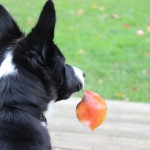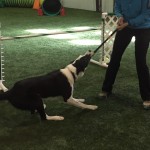First Principles Thinking – Reinforcement Builds Behavior
 Somehow or another, I can often relate interesting ideas from my general reading to dog training. Recently, I read an article that mentioned the term “First Principles Thinking”. It was defined with a quote by successful entrepreneur Elon Musk (Tesla, PayPal, Space X) : “First principles is kind of a physics way of looking at the world. You boil things down to the most fundamental truths and say, “What are we sure is true?” … and then reason up from there.”
Somehow or another, I can often relate interesting ideas from my general reading to dog training. Recently, I read an article that mentioned the term “First Principles Thinking”. It was defined with a quote by successful entrepreneur Elon Musk (Tesla, PayPal, Space X) : “First principles is kind of a physics way of looking at the world. You boil things down to the most fundamental truths and say, “What are we sure is true?” … and then reason up from there.”
In dog training, a fundamental truth is this: Reinforcement Builds Behavior. In other words, behaviors that my dog finds reinforcing will be repeated. Without getting too theoretical, this is the basic model:
Stimulus (change in environment)–> Behavior –> Reinforcement
Scenario 1: Squirrel runs –> Dog chases squirrel –> Dog’s prey instinct is satisfied
Scenario 2: Dog bowls clatter as dinner is prepared–> Dog comes running to kitchen –>Dog’s hunger is satisfied.
None of us have to teach our dogs the behavior of coming to eat dinner or chasing squirrels! Why? Because those behaviors are inherently reinforcing for the dog. Spend some time thinking of the behaviors your dog exhibits and then ask yourself why? Why does he run to the back door and bark? Why does he jump on people? Why does he drink out of the toilet bowl? It has to do with what he finds reinforcing.
Here is a starter list of things my dogs find reinforcing: access to food and water, sniffing, stalking, marking, chasing, chewing, barking, access to the outdoors, access to indoors, access to toys, access to ME, social interactions with people and other dogs, a comfy place to sleep, activities such as hiking, swimming, retrieving, tugging, possessing, fence running, snapping at flies. I’m sure you can add others. The important point is that dogs like these things and their behaviors are pretty much always about seeking those reinforcements.
What we are after as dog trainers is to build the behaviors we need for everyday life and dog sports. That means we have to use reinforcements (rewards) that our dogs love and that we can control. Remember, reinforcement builds behavior. Knowing WHAT is reinforcing to my dog is critical if I want to harness this truth for practical application. Trying to build behavior with something that my dog does NOT find reinforcing won’t get me very far. Just because my friend’s dog loves to chase a tennis ball, does not mean my dog will. Just because another dog will do anything for kibble, does not mean my dog will.
So the list of reinforcers (rewards) my dog loves and that I can control gets much shorter: Food in various forms that is easy to deliver, toys that allow interaction with me (e.g. tugging), praise and social interaction (petting).
 It’s worth the effort to build a repertoire of reinforcers that you can control and some rules around those rewards – like no grabbing at my hands for food or toys, like bringing the toy back to me, like playing with the toy I’m offering and ignoring the ones on the ground, like simply helping the dog learn that he must earn his rewards. But first be a good observer of your dog’s response to what you are offering as a reward. Only use what your dog wants when building behaviors. How do you know? One simple way is to watch your dog…after receiving the reward you offer, did the dog stay engaged? Or did the dog immediately make the choice to leave you for other reinforcement or – even momentarily – start to look around for something better? Or lose a little enthusiasm for his work?
It’s worth the effort to build a repertoire of reinforcers that you can control and some rules around those rewards – like no grabbing at my hands for food or toys, like bringing the toy back to me, like playing with the toy I’m offering and ignoring the ones on the ground, like simply helping the dog learn that he must earn his rewards. But first be a good observer of your dog’s response to what you are offering as a reward. Only use what your dog wants when building behaviors. How do you know? One simple way is to watch your dog…after receiving the reward you offer, did the dog stay engaged? Or did the dog immediately make the choice to leave you for other reinforcement or – even momentarily – start to look around for something better? Or lose a little enthusiasm for his work?
The relative value of a reward can vary depending on the environment. Your dog may love to tug at home but has difficulty focusing on the toy in agility class with lots of distractions. A better choice would be to use high-value food in class and keep working on building value for other rewards like toys in less distracting environments. Your dog may do flips for kibble at home, but in a highly distracting environment, a higher value food reward like tuna fudge or a tug toy may get better results.
Carefully observing your dog’s responses to the rewards you offer can help guide your training sessions. The fundamental truth is reinforcement builds behavior, so be sure to use something your dog perceives as reinforcing and you can control. It’s part of being a practical dog trainer.

Well stated!
That’s Eli. Toys are ok home but not much value at class with distractions
I’ve had dogs where I’ve had trouble finding reinforces,/rewards that I can control or provide that are better than what they might find in the environment around them. Squirrels, rabbits, scents of all kinds, people, etc. I have been really focusing on this with Pika and I think I am being rewarded too! She is young, but somehow all my efforts seem to have resulted in a dog who really does want to play with me, come with me etc. she still gets distracted but the time she takes to redirect to me is getting shorter and shorter and the distraction attractions less of a draw.
Karin: I agree…you and Pika look great together! Good work and recognition of building that relationship. Happy for you 🙂
Always good to be reminded of first principles! Thanks, Anne.
You are welcome Kelly!
These responses are not caused by over-arousal or the use of food in training, but by unclear criteria, unclear context cues, unhelpful defaults accidentally reinforced in past training sessions, and the resurgence of incomplete behaviors that were never fully put on cue to start.